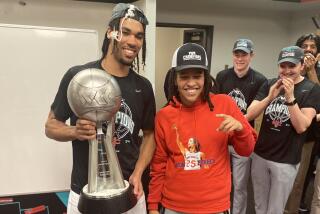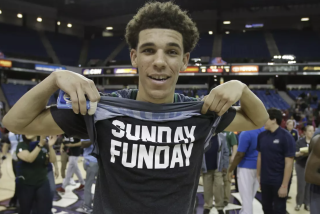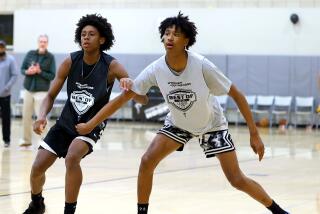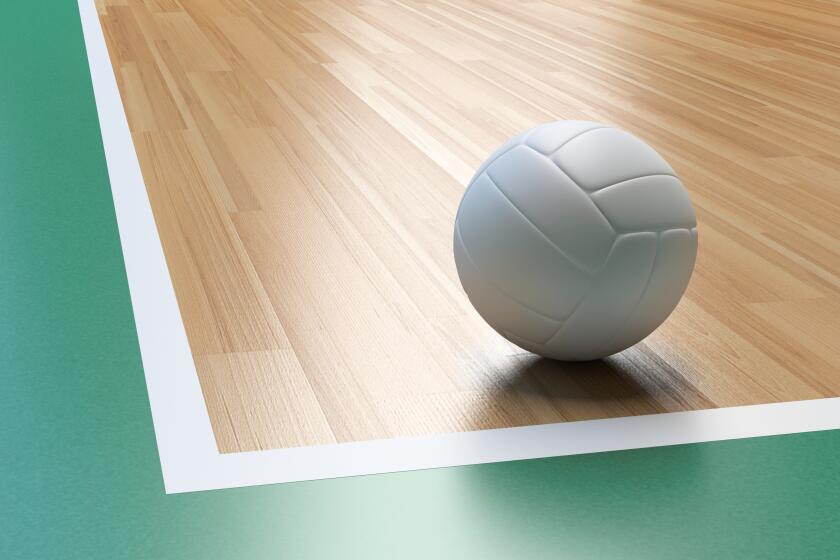Court Sense : Playground Basketball Taught CSUN’s David Keeter the Importance of Winning
David Keeter slumped forlornly on the bench while his teammates huddled in the locker room one last time. Keeter was nauseated and his head ached, but he still couldn’t stand missing Cal State Northridge’s game against New Mexico State.
For that matter, Keeter hates to miss any game. He sat out enough as a 16-year-old on a Hampton, Va., playground.
“It’s not like out here where you have 20 courts at every junior high and high school,” Keeter said. “There was one court every 10 miles so that’s where everyone would go. If you lost, you might as well go home because you wouldn’t get another game.”
Keeter always wanted one.
So every night after basketball practice, he pedaled down to the playground on the other side of town.
“I grew up in a good environment,” said Keeter, whose accent is a mix of southern drawl and a touch of Brooklyn he picked up from his transplanted buddies back home.
“I lived well, but I went to the rough places to play basketball because that’s where the best players play. Some of them were drug dealers . . . some of them were 30 years old.”
The court was even older and less kempt.
“There was only one light so you couldn’t shoot jumpers, you had to take it to the hoop,” Keeter said. “The asphalt was tore up so much it looked like little asphalt beads. It was real slippery.”
Yet Keeter found it superior to the sandlots he grew up on. Were it not for a sudden boredom with baseball, he would not be CSUN’s leading scorer.
“Basketball felt better,” Keeter said. “It was more exciting. You can’t just go out and play baseball, that’s why basketball is so fun. You can play any time.”
Keeter didn’t discover the joys of the game until he went out for the Hampton High team as a junior. Although he didn’t expect to make the cut, he ultimately started in the opener.
After averaging 14.7 points a game as a senior, he considered college basketball. But he had not considered college entrance requirements.
His 780 on the Scholastic Aptitude Test was better than the minimum required by Proposition 48, but his 1.8 grade-point average didn’t make the cut.
“I blew it,” Keeter said. “I was basically messing around. When my mom moved to California my senior year, my dad wasn’t real tough supervising me. I went to class, but going to class and learning are two different things.
“All I cared about was going around with my buddies and playing ball.”
After graduation in 1987, Keeter became an apprentice at the Newport News shipyard. There he did classified work for the government and played basketball on a shipyard team.
The following summer, he traveled to North Hollywood to visit his mother Liz, and, in typical Keeter fashion, he found an open gym and captured the interest of Hollywood High Coach Wendell Greer, who took Keeter to Torrance to meet El Camino College Coach Ronald McClurkin.
McClurkin was impressed by what he saw of Keeter in a pickup game and urged him to come to El Camino.
Liz, however, did not want her son to attend a school so far away.
“That’s a long bus ride,” McClurkin said, “but (David) said he didn’t want to go anywhere else.”
Liz not only relented, she moved to Torrance to ease David’s commute.
While McClurkin was happy to have Keeter fall into his lap, he saw him as nothing more than a reserve.
“I had guys I thought were bigger, stronger and more talented, but David outworked those guys,” McClurkin said. “Eventually he earned a starting spot. No one knew who he was and a lot of guys didn’t guard him.” By the end of the season they knew he was--a second-team All-South Coast Conference selection with a state-leading mark of 60% from three-point range.
They also knew how much he wanted to play ball. After breaking a knuckle on his shooting (right) hand, he continued to play with his middle fingers taped together.
In the off-season, Keeter underwent reconstructive surgery. A bone from his right hip was inserted, along with two plates, into the injured knuckle.
The rehabilitation took its toll, as did Keeter’s new status as a marked man. But by the start of conference play, McClurkin could count on Keeter for 16 points a game.
“His freshman year he just shot from the wing, but his sophomore year, he was really versatile,” McClurkin said. “He played inside as well as outside. His rebounds and assists picked up and one time we asked him to guard a 7-footer for us.”
That experience is paying off at CSUN, where a lack of team size has forced the 6-foot-5 Keeter from his natural shooting-guard position to small forward.
In just 21 minutes a game, he is averaging 15.7 points and 2.7 rebounds. He also has four steals, two blocked shots and a team-leading 50% average from three-point range.
He is far from a textbook gunner, however. One-on-one sessions as a 10-year-old against his shot-blocking 6-4 brother Ray forged a shot from behind the head and off to the side.
And although shooting is the main component of his game, Keeter takes more pride in his defense.
“I’d rather hold my man than hit the threes,” said Keeter, who has a linebacker’s mentality about defense.
“I just get mad to get ready for games,” Keeter said. “I take deep breaths. I don’t talk to anybody and I just get mad. When I get more emotionally involved, it makes me play harder and better.”
Perhaps that’s the legacy of a playground influence that will never wear off--a fear that the losing side sits out.
More to Read
Get our high school sports newsletter
Prep Rally is devoted to the SoCal high school sports experience, bringing you scores, stories and a behind-the-scenes look at what makes prep sports so popular.
You may occasionally receive promotional content from the Los Angeles Times.






